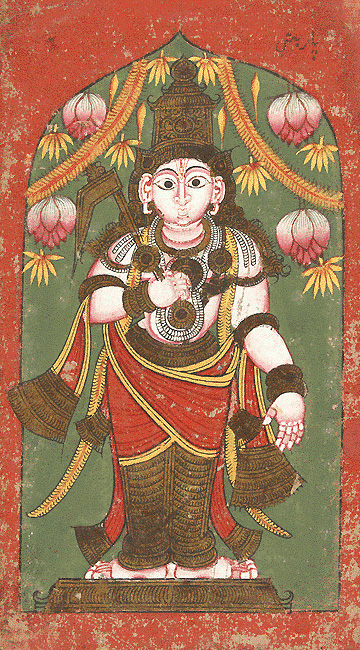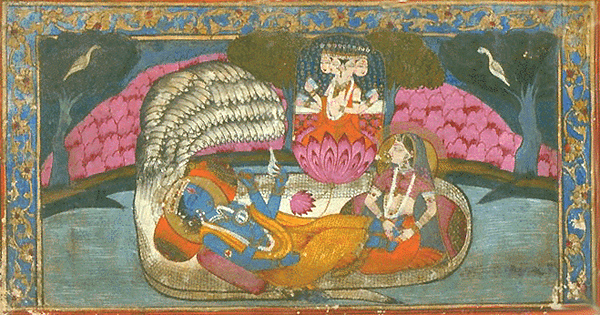The Appearance of Lord Balarama
BY: SUN STAFF

Aug 16, INDIA (SUN) — Today is the auspicious Appearance Day of Lord Balarama.
"That Maha-Visnu who lies on the Causal Ocean is actually an expansion of Balarama, who is Krsna's first expansion, and, in the Vrndavana pastimes, is the brother of Krsna. In the maha-mantra Hare Krsna, Hare Krsna, Krsna Krsna, Hare Hare. Hare Rama, Hare Rama, Rama Rama, Hare Hare, the word Rama refers to Balarama. Since Nityananda is an expansion of Balarama, Rama also refers to Lord Nityananda. Thus Hare Krsna, Hare Rama addresses not only Krsna and Balarama but Lord Caitanya and Nityananda as well."
Teachings of Lord Caitanya, Intro.
"Balarama is considered to be the elder brother of Krsna. When Krsna was present, Balarama became His elder brother. When Rama was there, this Balarama represented Himself as His younger brother, Laksmana. So Balarama is the first manifestation of His personal expansion."
Lord Krsna and Balarama (Baladeva) are not two different Personalities of Godhead. God is one without a second, but He expands Himself in many forms that are not separate from one another. They are all plenary expansions.
The sastras say everywhere that Krsna is the original Personality of Godhead and that He has innumerable avataras, or incarnations. After Krsna comes Balarama, after Balarama is Sankarsana, then Aniruddha, Pradyumna, Narayana and then the purusa-avataras--Maha-Visnu, Garbhodakasayi Visnu and Ksirodakasayi Visnu. All of them are avataras. Lord Brahma, born from the lotus flower from Garbhodakasayi Visnu, is an expansion of Balarama.
Lord Krsna is not an incarnation of the purusa, but is directly the original Personality of Godhead, and Balarama is the first plenary manifestation of the Lord. From Baladeva the first phalanx of plenary expansions, Vasudeva, Sankarsana, Aniruddha and Pradyumna, expands. Lord Sri Krsna is Vasudeva, and Baladeva is Sankarsana.
The Supreme Lord expands His personal forms in two primary categories. The prakasa forms are manifested by Lord Krsna for His pastimes, and their features are exactly like His. When Lord Krsna married sixteen thousand queens in Dvaraka, He did so in sixteen thousand prakasa expansions. Similarly, during the rasa dance He expanded Himself in identical prakasa forms to dance beside each and every gopi simultaneously. When the Lord manifests His vilasa expansions, however, they are all somewhat different in their bodily features. Lord Balarama is the first vilasa expansion of Lord Krsna, and the four-handed Narayana forms in Vaikuntha expand from Balarama. There is no difference between the bodily forms of Sri Krsna and Balarama except that Their bodily colors are different - the bodily hue of Krsna is dark and that of Balarama is fair. Similarly, Sri Narayana in Vaikuntha has four hands, whereas Krsna has only two. The expansions of the Lord who manifest such bodily differences are known as vilasa-vigrahas.

Lord Balarama is also the Sesa incarnation. Garbodakasayi Vishnu lies upon Ananta Sesa while dissolving the material creation. In the Upanisads it is stated that one cannot attain the supreme or any form of self-realization without being sufficiently favored by Balarama. Bala does not mean physical strength. No one can attain spiritual perfection by physical strength. One must have the spiritual strength which is infused by Balarama or Sankarsana. Ananta or Sesa is the power which sustains all the planets in their different positions. Materially this sustaining power is known as the law of gravitation, but actually it is a display of the potency of Sankarsana.
Since the Supreme Personality of Godhead is the Absolute Truth, everything in relation to Him is also on the same platform. ...The Lord's clothing, bedding, slippers and everything required as an ordinary necessity are all transformations of Sesa, Visnu, the expansion of Sri Baladeva. Thus the cloth and other paraphernalia of the Supreme Personality of Godhead are but other forms of the Supreme Personality of Godhead.

In the maha-mantra--Hare Krsna, Hare Krsna, Krsna Krsna, Hare Hare. Hare Rama, Hare Rama, Rama Rama, Hare Hare--the word Rama refers to Balarama. Since Lord Nityananda is an expansion of Balarama, Rama also refers to Lord Nityananda. Thus Hare Krsna, Hare Rama addresses not only Krsna and Balarama but Lord Caitanya and Lord Nityananda as well.
There are three Ramas. One Rama is Parasurama (Jamadagnya), another Rama is Lord Ramacandra, and a third Rama is Lord Balarama. These are some of the reasons why Balarama is known as Sankarsana, Balarama or sometimes Rama. In the maha-mantra--Hare Krsna, Hare Krsna, Krsna Krsna, Hare Hare. Hare Rama, Hare Rama, Rama Rama, Hare Hare--people sometimes object when Rama is accepted as Balarama. But although devotees of Lord Rama may object, they should know that there is no difference between Balarama and Lord Rama. Srimad-Bhagavatam clearly states that Balarama is also known as Rama (rameti). Therefore, it is not artificial to speak of Lord Balarama as Lord Rama.
If someone calls Lord Ramacandra by the vibration Hare Rama, or if he understands "Ramacandra," he is quite right. Similarly, if one says that Hare Rama means Sri Balarama, he is also right. Those who are aware of the visnu-tattva do not fight over all these details.
 Bhaktivedanta Book Trust. Paraphrased from text and purports of HDG A.C. Bhaktivedanta Swami Srila Prabhupada.
Bhaktivedanta Book Trust. Paraphrased from text and purports of HDG A.C. Bhaktivedanta Swami Srila Prabhupada.
